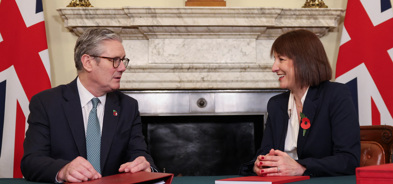The February Pulse
Highlights from the macroeconomic research ideas we have seen over the month
The value of investments can fall as well as rise and that you may not get back the amount you originally invested.
Nothing in these briefings is intended to constitute advice or a recommendation and you should not take any investment decision based on their content.
Any opinions expressed may change or have already changed.
Published on 26 Feb 20189 minute read

The idea behind the Pulse is to look at the highlights from the macroeconomic research ideas we have seen over the month. The two subjects we will review this month are the nature of a bear market (bearing in mind the volatility in February) and a discussion of the case for investing in the emerging markets.
What makes a bear market?
The risks to markets have been well illustrated by the volatility at the beginning of February. We believe this was not the beginning of a bear market but a reminder that the low volatility of 2017 was unusual. February was a rude reminder of normality.
Anyone interested in a definitive guide to identifying a bear market should read “The Anatomy of the Bear”, written by Russell Napier in 2005. It’s an engaging read and Russell, who predicted the 2008 financial crisis, is an equally engaging speaker.
In the meantime, Charles Gave at Gavekal Research recently wrote an interesting piece on the genesis of real bear markets, breaking them down into three categories. The first arises from excessive valuations, principally in equities, as illustrated by the bear markets of 1962, 1987 and 2000. These tend not to have a major impact on the economy and are relatively short-lived.
The second category is the ‘unexpected recession’, such as the post-1985 recession, which was borne out of an actual contraction in earnings. Common factors include a major shift in cost structures (oil in 1985) or demand shocks, and these bear markets tend to be painfully long (around 18 months).
The third is what Gavekal calls the ‘Ursus Magnus’, which is the result of ‘fatal conceit’ in policy makers. Fixed exchange rates, monetary union, price controls, trade barriers and artificially low interest rates are examples of the causes. The damage can last for decades and tends to be highly deflationary.
Which bear to fear?
One could argue that US equity valuations and developed market bond yields are signs of a potential valuation bear scenario. The recent fiscal stimulus in the US raises associated risks if it means interest rates rise faster than investors anticipate (in order to cool the US economy). However, Charles picks on Italy as the potential villain behind the next ‘Ursus Magnus’.
The trade surplus in Germany, which is now 9% of GDP, combined with the repatriation of portfolio flows (see our January Pulse), raises the risk of a significant appreciation of the euro, which would kill off Italy’s tepid economic recovery. The chart below shows how the European Central Bank's (ECB) bond-buying programme has kept Italian bond yields down, despite the risk posed by the appreciation of the euro.
If the euro does not appreciate then Donald Trump is more likely to target Europe with trade tariffs, which would achieve the same negative result for the European economy. If the ECB needs to respond to higher inflation, the coup de grâce would be a broad increase in interest rates which are held artificially low in the Eurozone.
An Italian dilemma
With Silvio Berlusconi’s centre-right coalition and possibly the populist Five Star movement the most likely to form a government in the March election, Italy is also poised to demand an end to fiscal discipline. This is a move which Brussels and the Bundesbank will forcefully resist in order to maintain stability in European bond markets. Aided by the ECB’s buying programme, they are likely to be successful but the point is that Italian debt is more likely to move to the front and centre of investor concerns this year.
A collapse of confidence in Italian credit should be avoided at all costs. With 132% debt to GDP, the costs of financing are critical to the stability of the Eurozone. The current Italian government budget deficit implies that even in this robust economic environment, the Ministry of Finance is only just keeping the debt load stable.
The elections look set to change this situation for the worse. Italy and the imbalances in Europe were kicked into the long grass when Mario Draghi promised to do “whatever it takes” in July 2012. The ‘fatal conceit’ of the euro is a tail risk we have become complacent about, but one that we cannot afford to ignore. At the Tilney Group we are currently positive and overweight European equities but would probably downgrade this position if either the euro or US dollar were to move above 1.30 or if the Italian fiscal position deteriorated materially.
Emerging markets
MSCI classifies markets as either developed, emerging or frontier. The classification criteria is a function of economic stability, liquidity, market capitalisation and accessibility. The basic rule of thumb is that the emerging markets (EM) have fewer large-cap companies than developed markets, their accessibility is good, the stability of their institutional framework is modest rather than excellent, and their Gross National Income per capita is less than US$15,000.
Our preference is for continued exposure to both EM local currency bonds and equities in our managed portfolios, despite the strong performance of both in 2017. Up to the end of 2016, EM economies suffered one of the worst earnings recessions of recent times. A combination of overvalued currencies, a collapse in commodity prices and a slowdown in global growth led to a 40% decline in the broad EM currency index and significant underperformance (around 28%) of the MSCI Emerging Markets equity index relative to the S&P 500. We believe that the conditions are now in place to justify a continuation of the return of the substantial assets that drained out of EM into the US during this period.
The 35% return in EM equities last year was from a low base and reflected a similar increase in earnings brought about by a recovery in global growth, improving supply/demand balances in commodities, and an end to significant fiscal austerity in the US. A research piece by Ashmore Asset Management highlighted that EM foreign currency reserves have been rising, evidencing that capital is flowing back from the US.
This accumulation of reserves has supported the 6% recovery in the EM currency index last year and is expected to continue. The research points out that EM Central banks may intervene if their currencies appreciate too much, but for now they are happy to add to their reserves for a rainy day.
Emerging market currencies and bonds
Currency flows
Normally, EM countries sterilise or offset foreign currency inflows by selling bonds in the domestic market. The intention is to neutralise the inflationary impact of the additional money supply and minimise the need to raise interest rates aggressively. However, sterilisation is rarely 100% effective and strong external currency flows tend to stimulate the domestic economy quite materially. Currency reserve accumulation is therefore intrinsically linked to growth and currency appreciation.
It is not just direct investments (FDI) that drive EM reserve accumulation. Most EMs add to currency reserves via trade surpluses, which depend on the strength of developed market (DM) consumers. In the long run, EM economies need to address this structural weakness and rely more on domestic consumption.
DM consumers are highly indebted and their dependence on low interest rates makes them a dangerous bedfellow. Long-run EM stability depends on the development of domestic consumption and less reliance on trade. The domestic consumer is growing fast in some countries, but for the moment it is fair to expect that the volatility of EM currencies and economies is likely to remain higher than their developed market equivalents for the foreseeable future.
Growth and interest rates
Buoyant global growth means that the volatility of EM capital and current account balances is currently a positive. Ashmore expects that EM currencies will appreciate by another 10% on aggregate before they face any valuation headwinds and that growth will be in the region of 4.9% in 2018. This compares to 2.7% growth in DM economies, and the gap is expected to widen further in 2019 as DM markets slow down.
Ashmore favours EM debt which, on average, offers a real yield of about 1.5% over an aggregate inflation rate of 4.5%, and sees good market opportunities for active managers in specific countries such as Brazil. The interest rate curves across key EM countries shown in the chart below highlight the significant premium yield over US Treasuries, and the average is approximately 4% above our UK inflation expectations. It could be argued that EM bonds are less vulnerable to re-pricing as DM quantitative easing rolls off.
10-year bond yields
China
China is a major component of the MSCI EM equity index but not yet a member of the EM debt benchmark due to limited access. However, China is clearly an increasingly important influence on global growth and EMs in particular. The declarations at the 19th Plenum suggest that growth in China is likely to slow in 2018, mainly due to the focus on controlling credit expansion and, in particular, the reining in of notorious Wealth Management Products (WMPs) sold to retail customers.
According to TS Lombard Research, the authorities are keen to improve transparency with increased regulation, but are also keen to avoid a liquidity crunch in the banking system as they tighten credit. Liquidity management will lower the risk of a growth shock for investors, and further enhancements of the successful supply side reform programme in the industrial sector will enhance productivity.
The beauty of a controlled economy, particularly when the data is heavily manipulated, is that the outcome will be perfectly in line with expectations. Nevertheless, a more significant deceleration of the ‘real’ GDP numbers is definitely a tail risk for 2018, with the potential to dampen both the EM and global growth pictures – and our optimism.
Politics
Additional risks for EMs this year include election politics in major markets such as Brazil, India and Mexico, and any unexpected strength in the US dollar. Mexico is due to hold elections on 1 July, and the twice-defeated Andres Lopez Obrador, now representing the left wing Morena Party, has a decent lead in the Presidential polls. Combined with potential changes to the North American Free Trade Agreement (NAFTA), the political risks in Mexico are high and are not yet fully priced in. Elections aside, the Mexican economy is improving. The central assumption is that NAFTA is unlikely to be materially negative, inflation is coming back to target and interest rates are likely to come down towards the year-end.
In Brazil, a significant improvement in investment flows and the strength of the global economy both provide a positive backdrop. However, the political uncertainties, with a probable delay on the approval of necessary structural reforms, will weigh on asset prices – therefore jeopardising the sustainability of the recovery. Like Mexico, equity valuations are relatively high, but in Brazil the scale of the output gap in the economy suggests non-inflationary growth potential and significant real earnings increases.
Still a good choice?
In summary, it is naïve to have a homogeneous view on emerging markets. As a rule, they are geared to a recovery in developed market growth but they have the advantage of relatively cheap currencies and attractive equity valuations.
Furthermore, capital flows are favourable and financial conditions are easing – a rising US deficit would be negative for the US dollar and a plus for EMs. In this context, EMs are an interesting option. They are likely to outperform a rising market and, having just been through an earnings recession, they have a good chance of breaking the habit of a lifetime by doing better than developed markets in a correction.
MSCI Emerging Markets index
Source: Bloomberg/MSCI.
For more information or if you have any questions, please get in touch by calling 020 7189 2400 or emailing contact@tilney.co.uk
Get insights and events via email
Receive the latest updates straight to your inbox.
You may also like…

Market news
2024 Autumn Budget Overview: The key announcements from Chancellor Rachel Reeves


Market news



